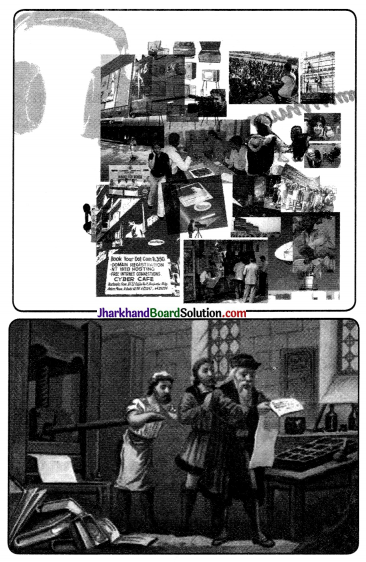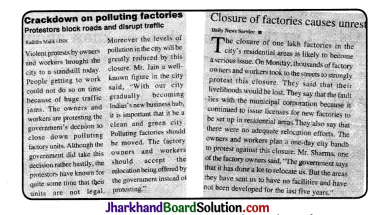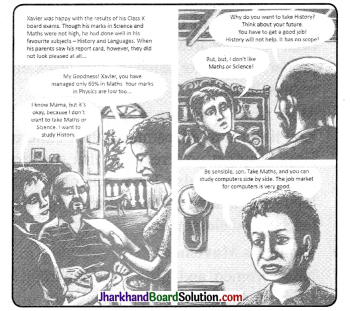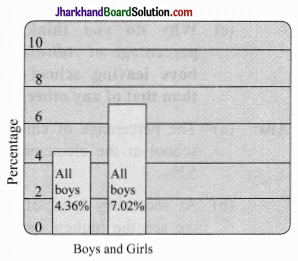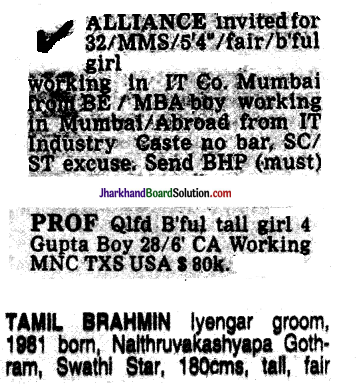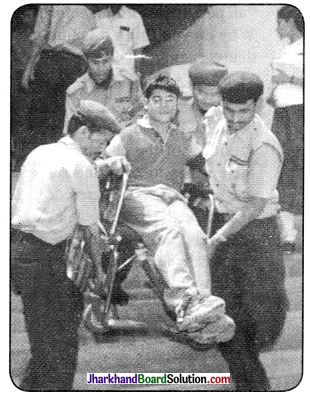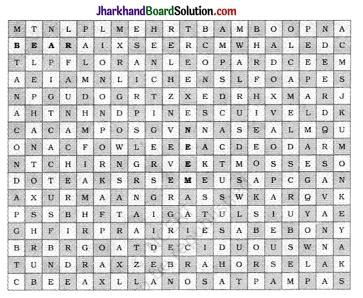JAC Board Class 7th Social Science Solutions Civics Chapter 7 Markets Around Us
JAC Class 7th Civics Markets Around Us InText Questions and Answers
Page 84
Question 1.
Why do people go to a weekly market?
Give three reasons.
Answer:
People go to the weekly market for thefollowing reasons:
- Most of the things people need are available at the same place. They don’t need to go to different places for different things.
- Prices are not fixed so they can bargain and buy the things.
- They get things at cheaper rates.
Question 2.
Who are the sellers in a weekly market? Why don’t we find big business persons in these markets?
Answer:
The sellers in the weekly market are the small traders. We don’t find big business persons in these markets because they have permanent establishments and shops to run their business. They also have their fixed and permanent customers. They earn good money and hence, they need to set up temporary shops in weekly market.
![]()
Question 3.
Why are things cheap in the weekly market?
Answer:
Things are cheap in the weekly market because the shops are not permanent there and hence, they don’t have to bear the expenses that a permanent shops have to. In weekly market, they set up shops for a day and close it in the evening. They don’t need hired workers to help them. The family members work together.
Question 4.
Explain with an example how people bargain in the market. Can you think of a situation where the bargain would be unfair?
Answer:
In the market, there are sellers and buyers. Most of the seller, demands for high prices as they want to earn more profit. Whereas, buyers want to buy the things at the minimum price. Hence, they start to bargain to bring the price down. After some discussion, they mutually agree on a bargained price and finally sell the product on that price to the buyer. In some places, we see the price is fixed. In such a case, if we bargain for the things that would be unfair.
page 85
Question 5.
Why did Sujata carry a notebook? Do you think this system is useful? Can there be problems?
Answer:
Sujata carried a notebook to note down the amount of things which she purchased from the shop as she bought the things in credit.
This system is useful to those who have low income. I don’t think there will be any problem in this system. Everything will go in a smooth manner if both the buyer and the seller are honest to each other. The buyer will not face any problems such as hunger and take things on credit and can pay later once he gets the salary or money. The seller will be ’nappy and not in ioss as weYl.
![]()
Question 6.
What are the different kinds of shops that you find in your neighborhood? What do you purchase from them?
Answer:
The different kind of shops that we find in our neighbourhood are dairy, roadside stalls, departmental stores, grocery shops, stationery shops, etc. I purchase milk and other dairy products from the dairy, medicines from chemist shop, vegetables and fruits from roadside stall, grocery from grocery shop.
Question 7.
Why are goods sold in permanent shops costlier than those sold in the weekly markets or by roadside hawkers?
Answer:
Goods sold in permanent shops are costlier than those sold in the weekly markets or by roadside hawkers because permanent shops are set up in buildings hence, they have to bear lots of expenses such as pay electricity, rent, wages to workers, fees and taxes to the governments. But, the roadside hawkers or weekly markets they don’t have to bear any such costs.
Page 86
Question 8.
Why do you think the guard wanted to stop Kavita and Sujata from entering the shop? What would you say if someone stops you from entering a shop in a market?
Answer:
The guard wanted to stop Kavita and Sujata from entering the shop because from their appearance, the guard might have guessed that they are from poor families who would not be able to buy expensive things from the mall. If someone stops me from entering a shop in a market then I will resist the person. I have full right to visit any shop even if I don’t have money or will not be able to buy expensive things.
Page 87
Question 9.
Why do people not bargain in shops located in malls whereas they bargain in weekly markets?
Answer:
People do not bargain in shops located in malls whereas they bargain in weekly markets because shops mostly sell the branded things with price tags which leave no scope fpr buyers to bargain. Whereas, in weekly markets, there are many shops selling the same kind of things which are not branded. This means that there is a competition. If someone sells goods at higher price, the buyer can move to another shop and bargain for that thing.
![]()
Question 10.
How do you think your neighbourhood shop gets its goods? Find out and explain with some examples.
Answer:
The neighbourhood shop gets its goods from the wholesaler. For example—the vegetable seller will buy the vegetables from the wholesaler and not from the farmer directly. Buying and selling takes place between traders and things reaches us as and when required.
Question 11.
Why is a wholesale trader necessary?
Answer:
A whole-sale trader is necessary because it is the person who makes the things and goods available to the retailers from whom different consumers buy different things as per their need.
JAC Class 7th Civics Markets Around Us Textbook Questions and Answers
Question 1.
In what ways is a hawker different from a shop owner?
Answer:
| A Hawker | A Sfclop Owner |
| • A hawker doesn’t have a permanent shop. It is a door to door service. | • A shop owner have a permanent shop. |
| • He sells his goods at minimum profit. | • Things are costlier. |
| • It is a kind of a movable shop where he keeps different types of things of every day use. | • Buyer has to go there if they require something. |
Question 2.
Compare and contrast a weekly market and a shopping complex on the following:
Answer:
| Market | Kind of goods sold | Prices of goods | Sellers | Buyers |
| Weekly market | ||||
| Shopping complex |
Question 3.
Explain how a chain of markets is formed. What-purpose does it serve?
| Market | Weekly market | Shopping complex |
| Kind of goods sold | Various items of our daily needs such as vegetables, groceries, etc. | Branded things such as home appliances, readymade clothes, footwear, etc. We also get eatables such as pizzas, pasta, burgers, etc. |
| Prices of goods | Are not very high. Common people can afford to buy easily. | Are very high. Only wealthy and rich people can afford to buy them. |
| Sellers | Small traders and hawkers | Big businessmen and traders |
| Buyers | People from low income group | Wealthy and rich urban people |
Question 3.
Explain how a chain of markets is formed. What purpose does it serve? .
Answer:
A chain of markets where there is a connection between producer, wholesaler and retailer in the following manner:
- We do not buy things directly from the factory or farm where generally the production takes place.
- The people who are in between the producer and the consumer is the trader.
- The wholesaler buys things and goods in huge quantities and bulk and then sell it to the traders.
- The traders or the retailers finally sells the things and items to the buyer or consumer.
- Hence, we may say that a chain of market is formed which is from factories to the final consumer.
This serves a great purpose as it maintains a flow of money. It also makes availability of daily requirements easy and help in maintaining the coordination in the society.
Question 4.
‘All persons have equal rights to visit any shop in a marketplace.’ Do you think this is true of shops with expensive products? Explain with examples.
Answer:
Yes, it is true of shops with expensive products. Consumers can visit any shop even though if they do not have money to buy it. The shop owners are bound to show the items and things which the consumer wants to see. It fully depends on the consumer whether the person wants to buy or not. The shop owner cannot compel him to buy. As in the case of Sujata and Kavita. They went to a shopping mall in curiosity. They were wandering in the mall and entered a shop. They didn’t have plan to buy anything as they were very expensive. They looked at few branded things and moved from that place.
![]()
Question 5.
‘Buying and selling can take place without going to a marketplace.’ Explain this statement with the help of examples.
Answer:
‘Buying and selling can take place without going to a marketplace.’ It means that one does not have go and buy things. They can order through phone or internet. The things and items will be delivered at home. For this we can pay online through debit and credit cards and after delivering at home as well. We see medical executives waiting for doctors in hospitals and clinics. They are also engaged in selling their products.
JAC Class 7thCivics Markets Around Us Important Questions and Answers
Multiple Choice Questions
Question 1.
The sellers sell the branded items in
(a) shopping malls
(b) weekly markets
(c) hawkers
(d) none of these
Answer:
(a) shopping malls
Question 2.
Online shopping is a shopping on
(a) internet
(b) phone
(c) door to door
(d) Both (a) and (b)
Answer:
(a) internet
Question 3.
We use for online purchases.
(a) PAN Card v
(b) Debit Card
(c) Credit Card N
(d) Both (b) and (c)
Answer:
(d) Both (b) and (c)
Question 4. In our neighbourhood, generally …….. is not found.
(a) dairy booth
(b) grocery
(c) shopping mall
(d) departmental store
Answer:
(c) shopping mall
![]()
Question 5.
The weekly market trader earns ……..compared to the profit of a shop owner.
(a) more
(b) less
(c) equal
(d) none of these
Answer:
(b) less
Question 6.
People who are not interested in selling small quantities are
(a) producers
(b) retailers
(c) wholesalers
(d) all of these
Answer:
(a) producers
Question 7.
The things which we will not find in the weekly market is/ are
(a) groceries
(b) branded items
(c) non-branded items
(d) vegetables
Answer:
(b) branded items
Question 8.
Accumulating things have become a status symbol now a days.
(a) non-branded
(b) semi-precious
(c) branded
(d) All of these
Answer:
(a) non-branded
Very Short Answer Type Questions
Question 1.
What do you mean by weekly market?
Answer:
A weekly market is a market which is held on a specific day of the week.
Question 2.
List few roadside stalls.
Answer:
Few roadside stalls are vegetable hawker, the fruit vendor and the mechanic, the cobbler, etc.
Question 3
What do you mean by wholesale market?
Answer:
Wholesale market is a place where goods first reach and then they are supplied to other traders in the region.
Question 4.
How do buyers are differently placed?
Answer:
Buyers are differently placed as there are many who can afford to buy in shopping malls as there the things are expensive while there are many who buy from weekly markets and hawkers as they get the cheapest of goods.
![]()
Question 5.
There is a competition among the shops in the weekly market. Why?
Answer:
There is a competition among the shops in the weekly market because there are many shops selling the same goods in the weekly market.
Question 6.
Why branded goods are expensive as compared to non-branded goods?
Answer:
Branded goods are expensive as compared to non-branded goods because branded goods are promoted by advertising which incurs a heavy costs, thus they are expensive.
Question 7.
Why fewer people can afford to buy branded goods?
Answer:
Only fewer people can afford to buy branded goods because branded goods are expensive.
Question 8
Who is the first key in the chain of markets?
Answer:
Producer is the first key in the chain of markets.
Question 9.
When is the chain of markets formed?
Answer:
Chain of markets is formed before the things are sold to the consumer or reaches the consumer.
Question 10.
Which is the largest fruits and vegetables market in Asia? How many retail vendors come everyday?
Answer:
The wholesale market at Azadpur, Delhi is the largest fruits and vegetables market in Asia. Approximately, 30,000 retail vendors come everyday.
Short Answer Type Questions
Question 1.
List the expenditure of the permanent shop owner.
Answer:
The expenditure of the permanent shop owner are:
- electricity
- rent
- taxes or fees to government
- wages to helpers.
Question 2.
Write a brief note about Aftab.
Answer:
Aftab is the wholesale trader who purchases goods in bulk. His business starts around 2 o’clock in the morning when vegetables reach the market. This is the time when the vegetable market or mandi starts buzzing with activity. The vegetables come in trucks, matadors, tractor trolleys from farms both near and far.
Soon the process of auctions and sale by bidding begins. Aftab decides what he will buy and participates in this auction. In the market, he has a shop where he stores the vegetables that he has bought. From this place, he sells to hawkers and shopkeepers who start coming to the market around six in the morning as they have to organise their purchases so that they can start their shop for the day around ten in the morning.
Question 3.
Which price is higher a retail or a wholesale price? Why?
Answer:
A retail price will be higher than the wholesale price. The reason is that the wholesaler sells at a higher price to retailer than charged by the producer to have a profit. Hence, in order to have a profit, the retailer sells it at a higher price than that he was sold at.
![]()
Question 4.
Why do most people choose shops in the neighbourhood?
Answer:
People choose shops in the neighbourhood because for their daily needs they can visit them any time. The shopkeeper and the buyer knows each other very well and things are also given on credit, if required.
Question 5.
Distinguish between permanent and temporary shop.
Answer:
Permanent Shops
- Permanent shop contains expensive and costly items.
- They store the items they sell in their shop.
Ibmpdrary Shops
- Temporary shops contains less expensive and low rate items.
- They store the items they sell in their home.
Question 6.
What do you mean by market?
Answer:
A place which is having shops, selling different kinds of things such as vegetables, fruits, stationary, medicines, clothes, etc. is known as market.
![]()
Question 7.
What are the various types of markets found?
Answer:
The various types of markets found are
- Wholesale market
- Weekly market
- Retail market
- Shopping complexes and malls
- Shops in the neighbourhood
Long Answer Type Questions
Question 1.
Discuss how people bargain in the market with an example. Can you think of a situation where the bargain would be unfair?
Answer:
Bargaining is a type of negotiation and discussion in which the buyer and seller of a good or service debate the price and exact nature of a transaction. If the bargaining reaches on agreement on mutual terms, the transaction takes place. Let’s understand with an example:
- Maya asked the shopkeeper, “how much this shirt costs?”
- Shopkeeper replied, “1000 rupees”.
- Maya promptly replied, “500 rupees”.
- Shopkeeper laughed and said, “Not possible, madam”.
- Maya replied, “700 rupees and this is the final price”.
- Shopkeeper replied, “Ok” and hand over the shirt to Maya.
- Bargaining would be unfair in the following cases:
- When we are getting the thing which is already at the lowest price and is of good quality.
- The person is economically weak who is selling the thing and his livelihood depends on what he sells.
Question 2.
What are the characteristics of weekly market and wholesale market?
Answer:
The characteristics of weekly market are:
- This market is found once in a week at a specific and particular place on a specific day.
- This is not a daily market.
- The traders set up temporary shops on the roadside or on open space for the day and closes it in the evening.
- The goods are relatively cheaper as they have no expenses such as rent, electricity, etc.
- The market sells almost everything such as lfom vegetables and fruits to the household things.
- People can bargain here as there are many shops where one can find the same thing everywhere in the weekly market.
- The characteristics of the wholesale market are:
- Wholesale market is a place where goods are sold in lower price and in bulk.
- A buyer can save lot of amount by buying from a wholesale market if he requires goods in bulk.
- The wholesalers do not sale goods in less quantity.
